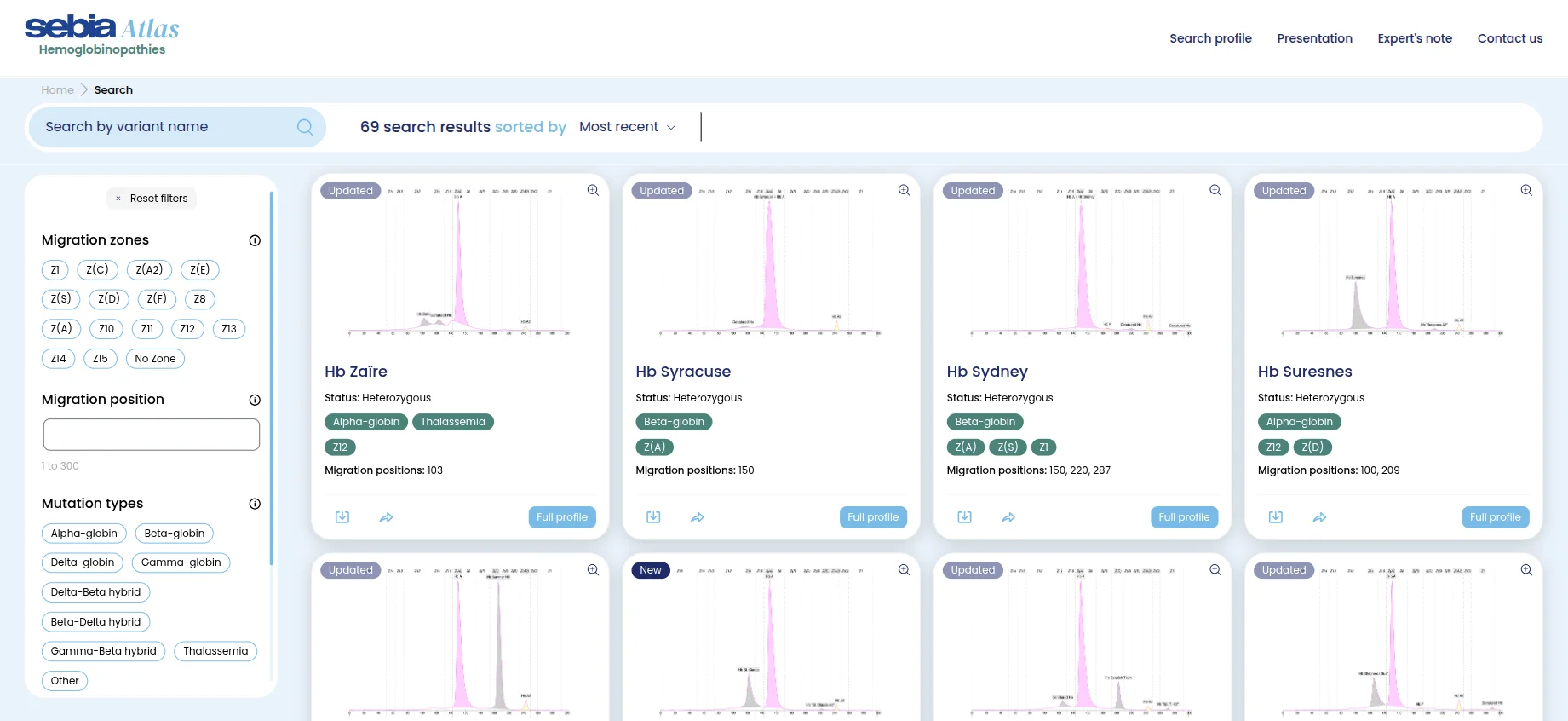How does this Atlas support laboratory professionals?
The purpose of this Atlas is to share with laboratory technicians and physicians personal insights and examples of hemoglobin separation obtained with the Sebia Capillary Electrophoresis device.
Effective interpretation of preliminary results requires experience, as it is essential for establishing a reliable provisional diagnosis that is in line with hematological data and complementary tests. This expertise also helps determine when DNA-level confirmation is necessary.

Methodology
The cases presented in this Atlas, generated using Sebia Capillary Electrophoresis (CE) systems, were collected from various laboratories around the world.
In addition to the most common hemoglobin variants – such as Hb S, Hb C, Hb D-Punjab, and Hb E – detailed in both heterozygous and homozygous forms, sometimes in combination with thalassemia, this Atlas also includes rarer, potentially unstable variants like for example Hb Lepore-Hollandia, Hb Köln, Hb Bassett, as well as several complex profiles resulting from combinations of different mutations.
This new edition features cases related to Sickle Cell Disease, including Hb S/S (associated with Sickle Cell Anemia), as well as other clinically relevant combinations such as Hb S with Hb C, beta-thalassemia, Hb D-Punjab, or Hb O-Arab. Some cases of non-Hb S Sickling variants, such as Hb C-Harlem, Hb C-Ziguinchor, are also presented. All these examples are intended to help laboratories presumptively identify the different forms of Sickle Cell Disease as simply and quickly as possible.
The significance of the hemoglobin variant cases presented in the Atlas lies in their clinical, diagnostic, and educational value, particularly for laboratories and healthcare professionals involved in the diagnosis of hemoglobinopathies such as Sickle Cell Disease (SCD). Here's why these cases are important:
1. Enhancing Diagnostic Accuracy
Capillary Electrophoresis is a powerful tool for identifying and quantifying normal hemoglobins and hemoglobin variants. By showcasing real-world examples – including common variants (Hb S, Hb C, Hb D-Punjab, and Hb E) and rare variants (like Hb G-Philadelphia or complex combinations) – the Atlas helps to:
- Improve recognition of electrophoretic patterns.
- Differentiate between similar profiles, such as Hb S/S vs. Hb S/β0-thalassemia or Hb S vs. rarer variants, for example Hb Fort de France & Hb Handsworth, positioned in the same migration zone.
- Avoid misdiagnosis, especially in geographic regions of high genetic diversity.
2. Supporting Early and Presumptive Diagnosis
The inclusion of diverse presentations of Sickle Cell Disease (e.g., Hb S/S, Hb S/C, Hb S/β0-thalassemia, Hb S/D-Punjab, Hb S/ O-Arab) allows laboratories to:
- Quickly identify likely cases of SCD based on electrophoresis profiles.
- Initiate timely follow-up testing, such as DNA analysis or hematological assessments.
- Guide early clinical intervention, which is crucial to the patient’s outcome.
3. Addressing Global and Genetic Diversity
By compiling cases from laboratories worldwide, the Atlas reflects the wide genetic variability of hemoglobinopathies:
- It highlights variants and combinations of variants specific to one region that may be under-recognized elsewhere.
- This global perspective is especially valuable for multicultural populations or areas with high levels of past and present migration.
4. Educational Resource for Training and Quality Assurance
For laboratory technicians, hematologists, experts and students, the Atlas serves as:
- A training tool to develop pattern recognition skills.
- A reference for rare or complex cases, including several references to the scientific literature for each hemoglobin case.
- A benchmark for Quality Control, helping laboratories to compare their interpretations with validated and genotyped examples.

Sebia
Over the last decades, Sebia’s Capillary Electrophoresis technology has become the benchmark for Hemoglobin analysis.
This can be attributed to its superior analytical performance, characterized by high-resolution, accurate, and reproducible electrophoretic profiles. Additionally, it ensures consistent results across various instrument platforms, enabled by the integration of a unified software environment.
Endorsed by leading national and international guidelines, the Sebia Capillary method has become the most widely adopted approach worldwide for first-line screening of hemoglobinopathies.
 Learn more about Sebia
Learn more about Sebia
